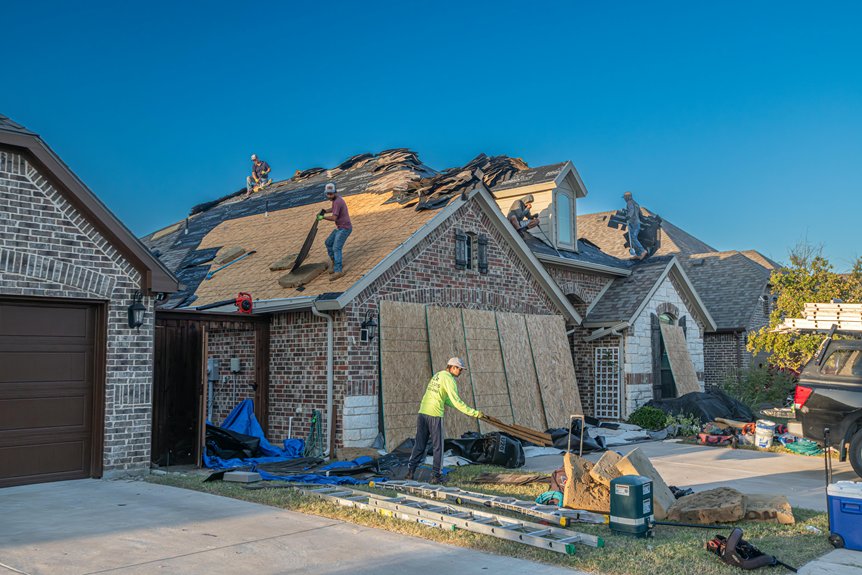Understanding how long your commercial roof will last in Texas requires considering the specific material, installation quality, and exposure to regional climate factors. With extreme heat, intense sun, and weather fluctuations, many roofing systems face accelerated deterioration. Knowing these variables helps you assess durability and plan for maintenance or replacement, yet the wide range of options—from asphalt shingles to green roofs—makes pinpointing an exact lifespan complex. Exploring these materials in detail reveals critical factors influencing longevity in this challenging environment.
Asphalt Shingles and Their Durability in Texas
Although asphalt shingles are among the most common roofing materials used in Texas, their durability heavily depends on climate conditions and installation quality. High temperatures can accelerate asphalt degradation, causing overall loss of flexibility and increased brittleness over time. Proper installation guarantees adequate ventilation, which mitigates heat buildup and prevents premature shingle failure. UV exposure from Texas’ intense sun can cause surface granule loss, reducing protection against weathering. Quality materials with mineral granules and advanced asphalt formulations resist moisture infiltration and thermal cycling. Regular inspection and maintenance are essential to detect early damage, prolonging the lifespan of asphalt shingle roofing systems in demanding regional climates. Additionally, choosing proper ventilation can significantly extend the durability of your asphalt shingle roof in Texas.
Metal Roofing: Longevity and Environmental Resilience
Metal roofing offers a compelling alternative to asphalt shingles, especially in Texas’s demanding climate. Its high resistance to extreme temperatures, high winds, and hail damage guarantees durability over decades, often exceeding 50 years with proper maintenance.
Metal panels are manufactured from galvanized steel, aluminum, or copper, providing corrosion resistance and structural integrity. Their reflective surface reduces heat absorption, improving energy efficiency.
Additionally, metal roofs are resistant to mold, rot, and pests, making them suitable for diverse environmental conditions. Proper installation and quality materials are vital to maximize longevity and resilience against Texas’s weather extremes.
Built-Up Roofing (BUR) Systems and Their Expected Lifespan
Built-Up Roofing (BUR) systems comprise multiple layers of bitumen and reinforcing fabrics that are hot-applied or cold-adhesive bonded to create a durable, weather-resistant membrane. Their layered construction provides robust protection against punctures, UV radiation, and thermal expansion.
In Texas, BUR systems typically last 15 to 30 years with proper maintenance, depending on installation quality, climate exposure, and periodic restorations. Regular inspections for surface cracking, membrane delamination, or blistering are essential for longevity.
When properly maintained, BUR roofs offer reliable service life, but exposure to extreme heat and temperature fluctuations can accelerate deterioration, reducing lifespan without timely repairs.
Single-Ply Membranes: TPO, PVC, and EPDM Durability Factors
Single-ply membranes such as TPO, PVC, and EPDM are engineered for durability through specific material properties and manufacturing processes, but their longevity depends on multiple factors.
TPO offers heat-welded seams and UV resistance, enhancing weatherability.
PVC benefits from chemical stability and strong seams.
EPDM’s rubber composition provides excellent flexibility and resistance to ozone and temperature fluctuations.
Durability is influenced by membrane thickness, installation quality, exposure conditions, and maintenance practices.
Proper UV protection, regular inspections, and timely repairs are essential to maximize lifespan.
In Texas, intense sunlight and temperature variations underscore the importance of selecting high-quality membranes and adhering to manufacturer guidelines.
Spray Polyurethane Foam (SPF) Roofs: Durability and Maintenance
Spray Polyurethane Foam (SPF) roofing systems are gaining popularity in Texas due to their seamless application and superior insulation properties, which contribute to overall roof durability. SPF creates a monolithic, airtight barrier that reduces thermal bridging and minimizes leak points.
Its closed-cell structure resists moisture absorption, enhancing longevity when properly maintained. Regular inspections should focus on cracks, surface wear, and coating integrity.
Applying reflective coatings protects against UV degradation, extending lifespan. Proper maintenance involves prompt repairs of damage, re-coating every 10-15 years, and ensuring seamless adhesion.
When correctly installed and maintained, SPF roofs can last 20-30 years, offering durability and energy efficiency in Texas’s climate.
Green and Living Roofs: Longevity Challenges and Benefits
Green and living roofs offer sustainable benefits by integrating vegetation directly into roofing systems, but they also present unique longevity challenges. The extensive moisture exposure, root infiltration, and biological activity can accelerate membrane degradation, requiring specialized waterproofing and root barriers.
Vegetation adds weight and insulation loads, demanding structural reinforcement and precise load calculations. Regular maintenance, including irrigation, pruning, and drainage management, is essential to prevent plant overgrowth and water retention issues.
Proper material selection, such as durable membranes and root-resistant substrates, extends system lifespan. Despite these challenges, with rigorous design and maintenance, green roofs can provide 40-50 years of functional performance, supporting environmental and energy efficiency goals.
Factors Affecting Commercial Roof Lifespan in Texas
The durability of commercial roofs in Texas is influenced by a combination of environmental conditions, material choices, and maintenance practices. Harsh climate factors like high temperatures, intense sunlight, and frequent severe storms accelerate material degradation and increase wear.
Selecting roofing materials with appropriate UV resistance and thermal stability can extend lifespan. Regular inspections, prompt repairs, and proper cleaning mitigate damage from debris and ponding water.
Additionally, installation quality and adherence to manufacturer specifications are critical. Understanding local weather patterns and choosing suitable materials tailored to Texas’ climate are essential for maximizing roof longevity and preventing premature failure.
Conclusion
Understanding the lifespan of commercial roofing materials in Texas helps you make informed choices. Proper maintenance, installation quality, and weather-resistant features considerably influence durability. Asphalt shingles may need replacement after 15-30 years, whereas metal roofs can last over 50 with proper care. Membranes and specialized systems require diligent upkeep to combat intense sun and temperature fluctuations. By selecting appropriate materials and adhering to maintenance protocols, you can maximize your roof’s longevity and ensure long-term performance in Texas’s demanding climate. For more information on how to schedule your free roof inspection, call us at (405) 543-2920 or visit us online at Top View Roofing.

